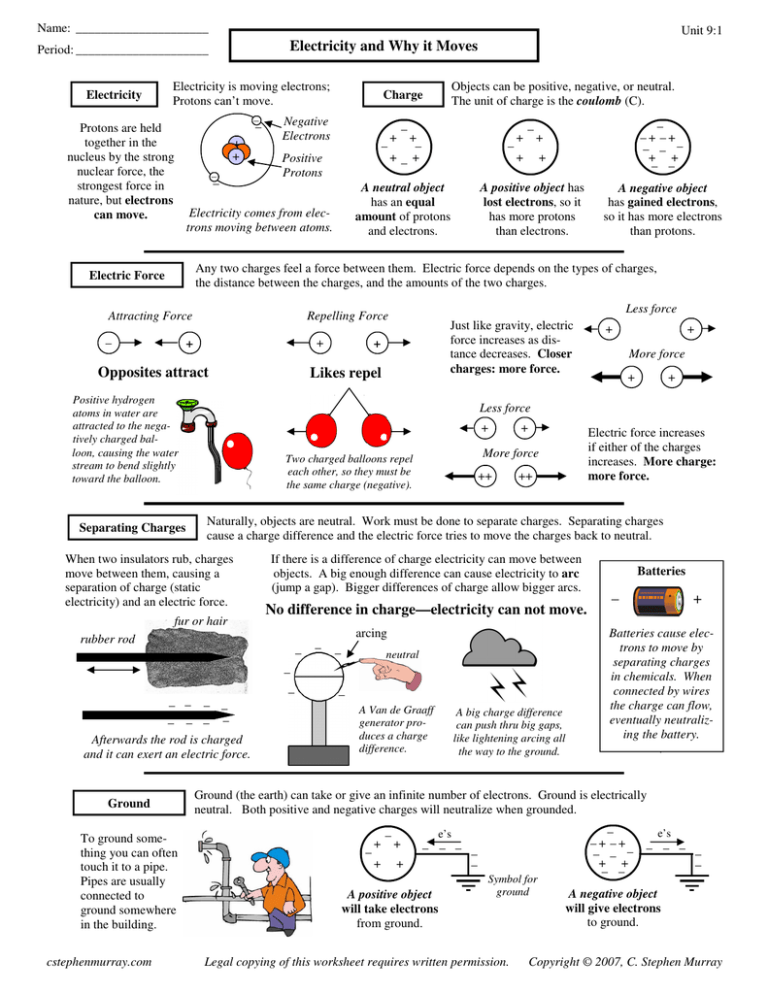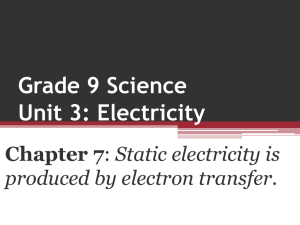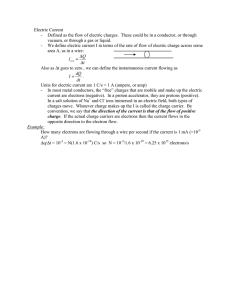Electricity and Why it Moves Likes repel Opposites attract No
advertisement

Name: _____________________ Unit 9:1 Electricity and Why it Moves Period: _____________________ Electricity Electricity is moving electrons; Protons can’t move. – – Protons are held together in the nucleus by the strong nuclear force, the strongest force in nature, but electrons can move. + + – – Objects can be positive, negative, or neutral. The unit of charge is the coulomb (C). Charge Negative Electrons + – + – – +– + Positive Protons – A neutral object has an equal amount of protons and electrons. Electricity comes from electrons moving between atoms. + – – –+ –+ – – – + + – – + + + A positive object has lost electrons, so it has more protons than electrons. Any two charges feel a force between them. Electric force depends on the types of charges, the distance between the charges, and the amounts of the two charges. Electric Force Attracting Force – + + Positive hydrogen atoms in water are attracted to the negatively charged balloon, causing the water stream to bend slightly toward the balloon. Separating Charges Less force Repelling Force Opposites attract Just like gravity, electric force increases as distance decreases. Closer charges: more force. + Likes repel + + More force + + ++ ++ Naturally, objects are neutral. Work must be done to separate charges. Separating charges cause a charge difference and the electric force tries to move the charges back to neutral. If there is a difference of charge electricity can move between objects. A big enough difference can cause electricity to arc (jump a gap). Bigger differences of charge allow bigger arcs. No difference in charge—electricity can not move. arcing rubber rod – – – neutral – – – – – – – – – – – Afterwards the rod is charged and it can exert an electric force. To ground something you can often touch it to a pipe. Pipes are usually connected to ground somewhere in the building. + Electric force increases if either of the charges increases. More charge: more force. More force Two charged balloons repel each other, so they must be the same charge (negative). fur or hair Ground + Less force When two insulators rub, charges move between them, causing a separation of charge (static electricity) and an electric force. cstephenmurray.com A negative object has gained electrons, so it has more electrons than protons. – A Van de Graaff generator produces a charge difference. A big charge difference can push thru big gaps, like lightening arcing all the way to the ground. Batteries – + Batteries cause electrons to move by separating charges in chemicals. When connected by wires the charge can flow, eventually neutralizing the battery. . Ground (the earth) can take or give an infinite number of electrons. Ground is electrically neutral. Both positive and negative charges will neutralize when grounded. – + + – + + e’s – – – – – A positive object will take electrons from ground. Symbol for ground Legal copying of this worksheet requires written permission. – –+ –+ – – – + + – – e’s – – – – – A negative object will give electrons to ground. Copyright © 2007, C. Stephen Murray Name: _____________________ Unit 9:1 Period: _____________________ 1. Positive 2. Negative 3. Neutral A. A push or pull caused by charges. 1. Ground A. The symbol for ground. B. The units for charge. 2. Arcing B. Moving electrons. 3. Charge Difference C. When a spark jumps between two objects. 4. Van de Graff D. Can accept or give an infinite amount of electrons. Will neutralize charge. C. When an object has more protons than electrons. 4. Coulombs D. When an object has an equal number of electrons and protons. 5. Electric force E. What keeps protons bound in the nucleus of an atom. 5. Electricity E. A machine that separates charge. 6. Strong Nuclear Force F. 6. F. When an object has more electrons than protons. Attract or Repel? ___ Two positive charges. What Charge: Positive (+), Negative (–), or Neutral (0)? + + ___ A positive and negative charge. ____ – –+ –+ – – – + + – – ___ – + + – + + + – ___ Two balloons on a string pushing apart. Causes an electric force and charges to move. ___ 2 protons and 4 electrons – ___ A 3 C charge and a –4C charge. – – ____ + – + – +– + ___ 18 protons and 16 electrons ___ A piece of rubber after rubbing it with fur. What are the charges of the second objects? – + Does the Electric Force increase or decrease? _____ If the distance between the charges increases? A balloon is rubbed against hair. Afterwards it sticks to a wall. A) Is the balloon attracted or repelled by the wall? B) Are the balloon and wall oppositely charged or like charged? You walk across a carpet. When you try to touch a door knob a spark jumps between you and the door knob. Why? _____ If one of the charges is bigger (increases)? _____ If both of the charges decrease (gets smaller)? _____ If the charges get closer? Two objects are charged, but do not arc. Give two ways to make them arc. A negatively charged rubber rod is brought close to the metal top of an electroscope. A) Will the electrons in the metal stay near the rod or move away from the rod? Rubber rod – – – – –– – – – Metal B) Why? C) On the diagram, draw where the electrons will go. leaves D) What will the metal leaves at the bottom do? cstephenmurray.com Electroscope An object has a charge of 4.5 C. A) Is the object positive or negative? B) Did it gain or lose electrons? C) If you touch it to ground, will it lose electrons to ground or gain electrons from ground? D) What will its charge be after it is grounded? Using the object at the right answer the following questions. A) Did it gain or lose electrons? B) When grounded, will it gain or lose electrons from ground? C) Draw a wire grounding it. D) What will its charge be after grounding? Legal copying of this worksheet requires written permission. –8C Copyright © 2007, C. Stephen Murray




